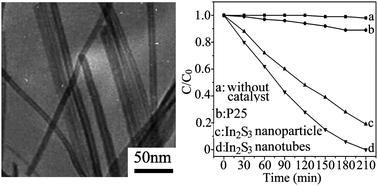Solvothermal preparation and visible photocatalytic activity of polycrystalline β-In2S3 nanotubes†
Abstract
Ultra-thin tetragonal β-In2S3

* Corresponding authors
a
Key Laboratory for Special Functional Aggregate Materials of Education Ministry, School of Chemistry and Chemical Engineering, Shandong University, Jinan, P. R. China
E-mail:
cdr@sdu.edu.cn
Ultra-thin tetragonal β-In2S3

 Please wait while we load your content...
Something went wrong. Try again?
Please wait while we load your content...
Something went wrong. Try again?
G. Liu, X. Jiao, Z. Qin and D. Chen, CrystEngComm, 2011, 13, 182 DOI: 10.1039/C0CE00084A
To request permission to reproduce material from this article, please go to the Copyright Clearance Center request page.
If you are an author contributing to an RSC publication, you do not need to request permission provided correct acknowledgement is given.
If you are the author of this article, you do not need to request permission to reproduce figures and diagrams provided correct acknowledgement is given. If you want to reproduce the whole article in a third-party publication (excluding your thesis/dissertation for which permission is not required) please go to the Copyright Clearance Center request page.
Read more about how to correctly acknowledge RSC content.
 Fetching data from CrossRef.
Fetching data from CrossRef.
This may take some time to load.
Loading related content
